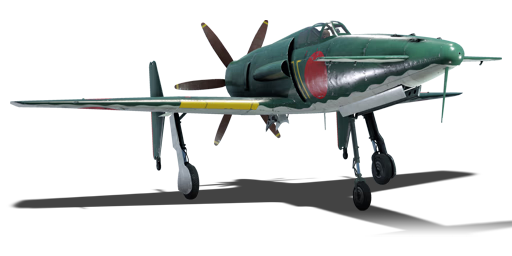



The J7W1, designated as Shinden (震電), was a prototype fighter plane featuring a distinctive design with wings positioned at the rear of the fuselage, a nose-mounted canard, and a pusher engine. Development was led by Masayoshi Tsuruno, beginning in 1942-43, with the aim of creating a high-speed 400 kn canard-type aircraft. This design aimed to maximize fuselage space by relocating the engine and pilot to the rear of the plane, thus allowing for more armament to be concentrated in the nose. As Japan's wartime situation deteriorated, the focus of the J7W1's development shifted from being a general fighter to a high-altitude interceptor. This change was driven by the increasing threat posed by American high-altitude bombing raids conducted by B-24s and B-29s. Despite its innovative design and potential, the J7W1 saw only limited production and testing. Only two prototypes were completed before Japan's surrender, preventing the aircraft from being deployed in combat.
It was introduced in Update 1.43. The Shinden is a bomber interceptor designed to make quick work of raiding bomber aircraft. It has exceptional performance at altitude, more than exceptional armament and a decent climb rate. Though double the weight of a fully loaded A6M, it is significantly faster to make up for it. This aircraft thrives with boom and zoom, and has a great energy retention at speed due to sleek aerodynamics. Inherently less stable than a normal tail plane thanks to the rear-mounted engine push thrust configuration canard design, the J7W1 is known for rapid pitch angle changes, great roll rate and less drag, by design.
flaps
flaps
flaps
brake
| Belt | Belt filling | Armor penetration (mm) at a distance: | |||||
|---|---|---|---|---|---|---|---|
| 10 m | 100 m | 500 m | 1000 m | 1500 m | 2000 m | ||
| HEF/HEF-I/HEF-T/APHE | 38 | 36 | 28 | 21 | 16 | 12 | |
| HEF-T/HEF-I/APHE/HEF/HEF | 38 | 36 | 28 | 21 | 16 | 12 | |
| HEF-T/APHE/APHE/APHE | 38 | 36 | 28 | 21 | 16 | 12 | |
| HEF-T | 5 | 5 | 4 | 3 | 3 | 3 | |
| HEF | 5 | 5 | 4 | 3 | 3 | 3 | |












Flight performance | |
|---|---|
Survivability |
|---|
Weaponry |
|---|